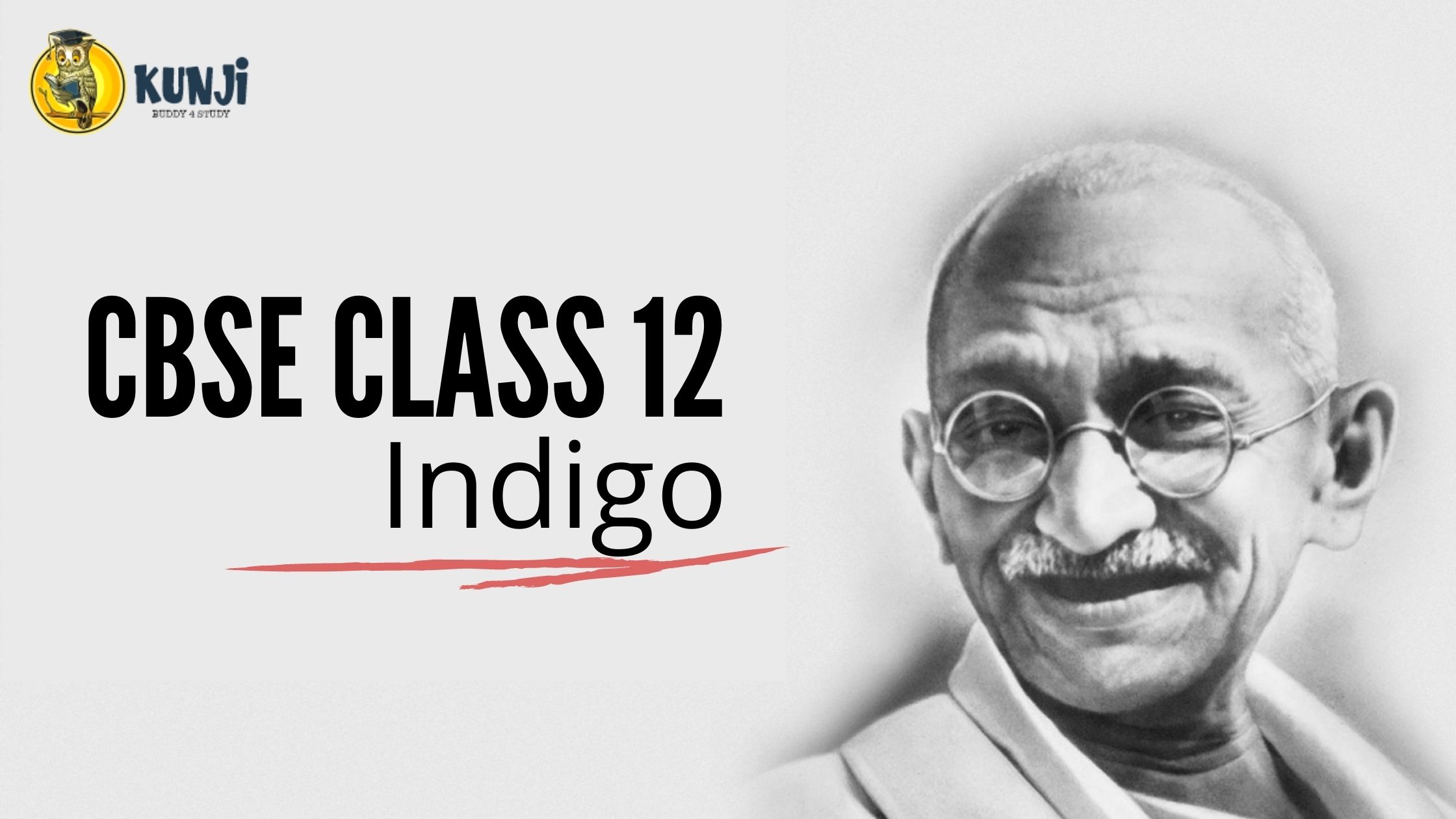Indigo
NCERT Solutions for Class 12 English Indigo lesson 5 are provided here with simple step-by-step explanations. These solutions for Indigo are extremely popular among 12th Class Science candidates for English Indigo Solutions come handy for quickly completing your homework and preparing for tests. All questions and answers from the NCERT Book of 12th Class Science English lesson 5 are provided here for you for free. You will also love the ad-free experience on Meritnation’s NCERT Solutions.
Indigo Lesson 5 Questions and Answers
Q.1 Strike out what is true in the following
(a) Rajkumar Shukla was
(1) a sharecropper
(2) a politician
(3) in the delegate
(4) a landlord
(b) Rajkumar Shukla was :
(1) poor
(2) physically strong
(3) illiterate
(4) literate
Q.2 Why is Rajkumar Shukla described as being resolute”?
Ans. Rajkumar Shukla is described as being ‘resolute’ because of his curiosity and determination to solve the poor peasant’s problems. In order to do this, he requests Gandhiji to come along with him to Champaran. Moreover, he follows Gandhiji wherever he goes, and at last, he succeeds in taking them along with him.
Q.3 Why do you think the servants thought Gandhi to be another peasant?
Ans. Raj Kumar Shukla often visited Rajendra Prasad with other farmers. He wanted Rajendra Prasad to help the indigo sharecropper. When Gandhiji visited him, the servants took him to be another peasant because of his simple attire and rustic outlook.
Q.4 List the places that Gandhi visited between his first meeting with Shukla and his arrival at Champaran.
Ans. Gandhiji had several appointments. At first, he went to Cawnpore (Kanpur). Then he came back to his Ashram at Ahmedabad. He also visited Calcutta, Patna, and Muzaffarpur before going to Champaran.
Q.5 What did the peasants pay the British Landlords as rent? What did the British now want instead and why? What would be the impact of synthetic indigo on the prices of natural indigo?
Ans. The peasants paid the entire indigo harvest to British landlords as rent. The British landlords mean while leamed that Germany had developed synthetic indigo. So they obtained agreements from the sharecroppers to pay them the compensation for the 15 percent agreement. It would diminish the demand for the indigo grown in the fields of the British landlords.
Q.6 The events in this part of the illustrate Gandhi’s method of working. Can you identify some instances of this method and link them to his ideas of paragraph and non-violence?
Ans. Every one of us know that Gandhiji challenged the British Empire, the most powerful empire of the world. Moreover, he won the battle without any arms He used the weapon of love, peace, non-violence, and brotherhood. The events in this part of the text describe his ideas of satyagraha and nonviolence. There are many instances during the Indian freedom movement e.g – Chauri- Chaura kand Jallianwala Bagh Massacre, etc. But Gandhiji did not lose his in non-violence and satyagraha.
Q.7 Why did Gandhi agree to a settlement 25 percent refund to the farmers?
Ans. Gandhiji agreed to a settlement of 25 refunds to the farmers. In order to defend the side, he explained that the amount was less important than the fact Landlord had been obliged to surrender part of their money along with their prestige. Events justified Gandhi’s position. Within a few years, the British planters abandoned their estates. Because of this long term profit, he agreed to a settlement of 25 percent to the farmers
Q.8 How did the episode change the plight of the peasants?
Ans. The episode changed the plight(sad situation of the peasants by letting the British abandon their estates within a few years.Now, the land was back with the peasant and the indigo sharecropping disappear. Moreover, this episode affected the psychology Now the peasants realized they must claim their rights. They regained courage.
Q.9 Why do you think Gandhi Considered Champaran episode to be a turning point in his life
Ans. We think that Gandhiji considered the Champaran episode to be a turning point in his life. It is due to this episode he came to know the real problems of the people’s political, social, and cultural problems that they faced. He tried his level best to uplift their status by providing elementary education with the help of other social workers. Gandhiji saw the pathetic condition of his people. He wanted to free India from foreign rule. He also wanted to uplift the social of the people. He advocated love, peace brotherhood. He always favored non-violence.
Q.10 How was Gandhi able to influence lawyers? Give instances.
Ans. Gandhiji was able to influence lawyers Because of some of his attitude, care, and love for poor people. He used to set examples before others. In one of the instances, he was ready to go to jail for the poor peasants. He was unknown to them, but for the sake of his countrymen, he was even ready to die. This patriotic attitude influenced the lawyers and they were ready to go to jail with Gandhiji.
Q.11 “Freedom from fear is more important than legal justice for the poor.” Do you think that the poor of India are free from fear after Independence?
Ans. The statement was given by Gandhiji. “Freedom from fear is more important than legal justice for the poor” is true. Fear of starvation, hunger, death was there before Independence. But it is true that such type of fear is still present today. No doubt that we have fundamental rights today, though we are free, yet the poor are suffering because of social, economic, and political inequalities.
Q.12 What are the qualities of a good leader?
Ans. A leader in the path maker of his countrymen. Gandhiji was an ideal leader. He was bold and honest. All the qualities possessed by Gandhiji are the qualities of a true leader,
Some of the qualities of a good leader are as follows:
(1)Quality of leadership,
(2) Quality of decision making and hardworking,
(3) Quality of integration and truthfulness.
(4)Quality of high thinking and simple living
(5) Quality of sacrifice.
Q.13 Who is the writer of the lesson “Indigo? Where from has it been taken out?
Ans. Louis Fischer is the writer of the lesson “Indigo. He wrote one of the best books on Gandhi with the title “The life of Mahatma Gandhi’. The lesson has been taken from that book.
Q.14 What was Gandhi’s conclusion for providing real relief to sharecroppers?
Ans. It was concluded that they should stop going to law courts. It does little good. The peasants were crushed and fear-stricken, law courts were useless. The real relief for them was to be free from fear.
Q.15 What was the sharecropping contract?
Ans. The peasants were compelled to grow three – twentieths or 15 percent of their landholding with Indigo. The entire Indigo harvest was to be given as rent.
Q.16 Did Gandhiji leave Tirhut? Where did he go?
Ans. Gandhiji did not leave Tirhut but proceeded with several lawyers to Motihari, the capital of Champaran.
Q.17 What was the report Gandhiji received in his Motihari headquarters?
Ans. A report came in that a peasant had been maltreated in a nearby village. Gandhiji decided to go there.
Q.18 When did Gandhiji exclaim, “The battle of Champaran is won?”
Ans. Gandhiji in a conference with the prominent lawyers asked them what would they do if he was sent to jail. The lawyers had finally to declare that they would follow him into jail. Then Gandhiji exclaimed, “The battle of Champaran is won.”
Q.19 Who were Mahadev Desai and Narhari Parikh ?
Ans. The two young teachers were Gandhi’s new disciples. With their wives, they volunteered for the work at Gandhi’s appeal to remove the social and cultural backwardness of Champaran villages.
Q.20 How did Gandhiji help the peasants Champaran villages?
Ans. Mrs. Gandhi taught about personal cleanliness and community sanitation. She also taught ashram rules’ in the new schools opened in six villages. She taught women to maintain the cleanliness of dresses, cleanliness of their houses, and their surroundings.
Q.21 Give another issue that has provoked a controversy like the Bhopal Gas Tragedy or the Narmada Dam Project in which the lives of the poor have been affected.
Ans. There are many issues that have provoked a controversy like, that of the Bhopal Gas tragedy or the Narmada Dam project in which the lives of the poor have been affected, viz Pong Dam case in Nurpur Tehsil of Distt. Kangra, Himachal Pradesh. Govt promised native landowners to provide them land in other places but failed to stand by its promise. Several people are without shelter and not properly compensated. Some of them had to go to court to seek justice.
Q.22 How did Gandhiji help the peasants Champaran?
Ans. Gandhiji fought for the rights of peasants of Champaran. He agreed to a settlement of a 25 percent refund to the farmers. In this way, he helped the peasants of Champaran.
Q.23 How do we know that ordinary person to contribute to the freedom of movement?Answer your question in reference to lesson INDIGO’
Ans. The chapter INDIGO’ presents the story of an ordinary farmer named, Rajkumar Shukla. Rajkumar Shukla was fighting against the discrimination done to the Indian farmers by British rulers. He took help Gandhiji. He had to wait for long for his first meeting with Gandhiji. It shows the determination of an ordinary farmer. Later on, with the help of Gandhiji Indigo sharecroppers got justice. At that time it was not just a complaint of Rajkumar Shukla. It has become a mass movement. Many famous leaders of freedom movement joined Gandhi in this movement. The real heroes of the movement were Rajkumar Shukla and fellow farmers. After this incident, the general public joined Gandhiji in the freedom struggle. This way we come to know that ordinal people contributed to the freedom movement.





